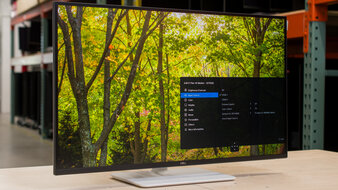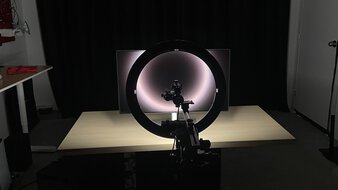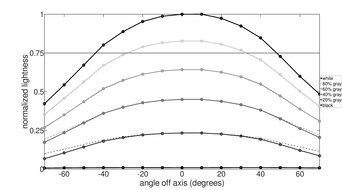If you're a programmer looking for a new monitor, there are plenty of great options you can choose from. Even if most monitors aren't specifically designed with programming in mind, many include productivity-focused features that can help while you're working. When looking for a monitor, there are a few factors to consider. Large screens can help you see more of your lines of code at once, but keep in mind that size is a personal preference, so there's no perfect solution for everyone. On top of that, having a high resolution can result in sharp text clarity.
There are also a few performance-related aspects you should consider for programming. For example, monitors with wide viewing angles and good ergonomics are also beneficial if you constantly need to share your screen with a coworker to show them your work. If you code in a dark room while using a dark mode, having a high contrast ratio can help display deep blacks next to white text, and a monitor with high brightness is mainly beneficial in a well-lit room.
We've bought and tested more than 365 monitors, and below are our recommendations for the best programming monitors. Also, check out our recommendations for the best ultrawide monitors, the best monitors for dual setup, and the best USB-C monitors. Also, see the best laptops for programming and the best keyboards for programming.
Quick Look






Looking to save on your next monitor? We've got you covered! Check out our Early Black Friday 2025 Deals article to see what's worthwhile this year.
-
Best Monitor For Programming
 Office8.5SDR Picture7.5Text Clarity9.0SDR Brightness8.3Ergonomics9.7Size27"Pixel TypeIPSMax Refresh Rate120 HzSee all our test resultsNative Resolution3840 x 2160
Office8.5SDR Picture7.5Text Clarity9.0SDR Brightness8.3Ergonomics9.7Size27"Pixel TypeIPSMax Refresh Rate120 HzSee all our test resultsNative Resolution3840 x 2160The best monitor for programming that we've tested so far is the Dell U2725QE, which you can get from Dell's website if you can't find it through any retailer. It's a 27-inch, 4k monitor with a ton of features that help with multitasking. This includes a massive USB hub with five USB-A ports and five USB-C ports, so you can connect all kinds of devices directly to the monitor. It supports Thunderbolt 4, which is great if you have a Thunderbolt laptop, and its 140W of power is enough to charge even the most power-hungry laptops. It also has two separate video outputs, meaning you can connect two external monitors directly to this for a multi-monitor setup.
Besides these features, it also delivers good picture quality for programmers. It has a decent contrast ratio thanks to its IPS Black panel, so it displays deeper blacks than other IPS displays when using dark mode, but it still doesn't have the near-perfect contrast ratio of an OLED. Its high resolution also delivers sharp text, and the 27-inch screen is big enough to open two windows side-by-side. However, if you want something bigger, you can also check out the similar Dell U3225QE, but it's a lot more expensive with similar performance.
-
Best Ultrawide Monitor For Programming
 Office8.1SDR Picture7.5Text Clarity9.0SDR Brightness7.5Ergonomics7.7Size40"Pixel TypeIPSMax Refresh Rate120 HzSee all our test resultsNative Resolution5120 x 2160
Office8.1SDR Picture7.5Text Clarity9.0SDR Brightness7.5Ergonomics7.7Size40"Pixel TypeIPSMax Refresh Rate120 HzSee all our test resultsNative Resolution5120 x 2160If you find the 16:9 aspect ratio of the Dell U2725QE too narrow and you prefer an ultrawide screen with a 21:9 aspect ratio, check out the Dell U4025QW. The main advantage of getting this is if you want more horizontal screen space to open multiple windows next to each other. Besides that, it's actually very similar to the U2725QE, as it has the same number of USB ports, but one difference is that it doesn't have a DisplayPort output, so it only has one video output instead of two.
On the plus side, it uses an IPS Black panel, so it displays fairly deep blacks in dark rooms. With a 5k2k resolution, text looks incredibly sharp, too. It even has good brightness, but its reflection handling is just okay, so visibility is an issue if you have it next to a sunny window. Keep in mind that this monitor is expensive, so you should only consider it if you're going to make full use of its large screen. However, there's also the Dell U3425WE if you want a cheaper ultrawide with a smaller screen, but text isn't as sharp due to its lower resolution.
-
Best Mid-Range Monitor For Programming
 Office8.5SDR Picture6.9Text Clarity9.0SDR Brightness8.1Ergonomics9.5Size27"Pixel TypeIPSMax Refresh Rate60 HzSee all our test resultsNative Resolution3840 x 2160
Office8.5SDR Picture6.9Text Clarity9.0SDR Brightness8.1Ergonomics9.5Size27"Pixel TypeIPSMax Refresh Rate60 HzSee all our test resultsNative Resolution3840 x 2160If you find that the ultrawide screen of the Dell U4025QW is too big for your needs, and you don't have the budget for the Dell U2725QE, look into the ASUS ProArt Display PA279CRV. With a 4k, 27-inch screen, text is as sharp as on the U2725QE, but there are a few trade-offs for getting something cheaper. Firstly, it has fewer features as it has a smaller USB hub and doesn't support Thunderbolt or have a KVM switch. However, it still supports DisplayPort Alt Mode with 90W of power delivery, so you can easily connect your laptop to it, and it has three USB-A ports to connect other devices.
Another difference with the U2725QE is that it has a much lower contrast ratio, so blacks look even more gray, which is disappointing if you use your system or program's dark mode. That said, it's still a decent choice to use in a bright room as it gets bright enough to fight glare, but bright reflections are distracting. It also comes with a very ergonomic stand, making it easy to adjust to your ideal position.
-
Best Budget Monitor For Programming
 Office8.4SDR Picture7.4Text Clarity9.0SDR Brightness8.0Ergonomics9.2Size27"Pixel TypeIPSMax Refresh Rate120 HzSee all our test resultsNative Resolution3840 x 2160
Office8.4SDR Picture7.4Text Clarity9.0SDR Brightness8.0Ergonomics9.2Size27"Pixel TypeIPSMax Refresh Rate120 HzSee all our test resultsNative Resolution3840 x 2160Should you be looking for a monitor for programming and you're on a budget, check out the Dell S2725QS. It's another 4k, 27-inch monitor, so it delivers the same sharp text as the ASUS ProArt Display PA279CRV, with enough screen space to open two windows side-by-side. However, the main trade-off of getting this monitor instead of the ASUS is that it doesn't have any USB ports, so you can't connect your keyboard and mouse directly to the monitor, and you have to charge your laptop separately.
Regardless, it's a solid budget-friendly monitor that offers the basics for work, as it has wide viewing angles that keep the image consistent when you're sharing the screen with a coworker next to you. Plus, its ergonomic stand makes it very easy to adjust. Like the ASUS, it also gets bright and is a good choice for a moderately-lit office space, but reflections are distracting if you have it opposite a sunny window. It's a bad choice for coding in dark rooms, though, as it has a low contrast ratio and lacks a local dimming feature to further improve the contrast.
-
Best Cheap Monitor For Programming
 Office7.1SDR Picture6.7Text Clarity7.0SDR Brightness6.6Ergonomics9.4Size24"Pixel TypeIPSMax Refresh Rate100 HzSee all our test resultsNative Resolution1920 x 1080
Office7.1SDR Picture6.7Text Clarity7.0SDR Brightness6.6Ergonomics9.4Size24"Pixel TypeIPSMax Refresh Rate100 HzSee all our test resultsNative Resolution1920 x 1080Should you be looking for the best monitor for coding that's cheap and simple, then look into the Dell P2425H. You can get it for a cheap price from Dell's website. It's a basic, entry-level monitor that has a lower resolution than the Dell S2725QS, which is what you have to expect from low-cost monitors, and it has a smaller screen, too. This means text isn't as sharp, but the text clarity is decent enough for coding. Though, its smaller screen makes it a good choice if you prefer something small or you want to get two of them to use side by side.
Regardless, it has more features than other cheap monitors, as it has a USB hub. It has three USB-A ports and a USB-C port, but it doesn't support DisplayPort Alt Mode, so the USB-C port is meant for data transfer or charging and not for video signals. Besides that, it also has an incredibly ergonomic stand, so it's easy to adjust. Unfortunately, it doesn't get bright enough to fight intense glare, so it's best to use this in a dim room.
Notable Mentions
-
BenQ MOBIUZ EX321UX:
The BenQ MOBIUZ EX321UX is a premium 4k, 32-inch monitor that gets much brighter than the Dell S2725QC. It's something to consider if you work in a bright office space, but it also costs more than the Dell. Plus, the Dell has a bigger USB hub than the BenQ.
See our review -
Dell S2725QC:
The Dell S2725QC is an entry-level 4k monitor that sits just above the Dell S2725QS. You should go for the S2725QC if you want something with a USB hub, but it costs more than the S2725QS.
See our review -
ASUS ProArt Display PA27JCV:
The ASUS ProArt Display PA27JCV is a 5k monitor with higher pixel density than the Dell U2725QE. It also has an IPS Black panel with a decent contrast ratio. However, the ASUS has a smaller USB hub and costs more than the Dell.
See our review -
MSI G274QPF-QD:
The MSI G274QPF-QD is a cheap 1440p monitor that has a higher resolution and bigger screen than the Dell P2425H. It's something to consider if these are important to you, but the MSI can be harder to find.
See our review
Recent Updates
Oct 01, 2025:
We replaced the Dell P2423D with the Dell S2725QS, which has a higher resolution and is easier to find. In the Notable Mentions, we replaced the Acer Nitro XV275K P3biipruzx and the Dell S2722QC with the BenQ MOBIUZ EX321UX and the Dell S2725QC, respectively, and we added the MSI G274QPF-QD.
May 29, 2025:
We replaced the Dell U2723QE with the Dell U2725QE, which has additional features. We also added the ASUS ProArt Display PA279CRV as the 'Best Mid-Range Monitor.' We replaced the Dell S2721QS with the Dell P2423D, as the S2721QS is harder to find. Lastly, we replaced the Dell U3223QE and the LG 27GP850-B/27GP83B-B with the Acer Nitro XV275K P3biipruzx and the ASUS ProArt Display PA27JCV in the Notable Mentions.
Feb 19, 2025:
We introduced a new format to the article and updated the text to reflect these changes. We also removed the ASUS ProArt Display PA279CRV, as it's very similar to the Dell U2723QE and has better contrast.
Dec 05, 2024:
We swapped the Dell S2722QC with the ASUS ProArt Display PA279CRV between the 'Best Mid-Range Monitor' and the Notable Mentions because the ASUS has more features and for consistency with other recommendations.
Sep 18, 2024: We replaced the Dell U3223QE with the Dell U2723QE to be consistent with other recommendations. We also replaced the Dell G2724D with the Dell P2425H, which has more productivity features. We updated the Notable Mentions by replacing the ASUS ProArt Display PA278QV and the LG 40WP95C-W with the G2724D and the U3223QE.
All Reviews
Our recommendations are based on what we think are the best displays for coding and programming that are currently available. They're adapted to be valid for most people in each price range. The rating is based on our review, factoring in price and feedback from our visitors.
If you would prefer to make your own decision, here's the list of all of our monitor reviews. Be careful not to get too caught up in the details. Most monitors are good enough to please most people, and the things we fault monitors on are often not noticeable unless you really look for them.















